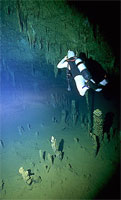
New Caledonia is located 1,750 km east of Australia in the South Pacific Ocean. It is an overseas territory of France. The Isle of Pines, which is the Southern most Melanesian Island is situated 70km southeast of the main island of New Caledonia.
Captain Cook, when first sighting the island in 1774, thought the colonial pines, from which Isle of Pines got its name, to be stalagmites.
The island is 17km long by 14 km wide and rises 256m above sea level. It is in fact a raised atoll without rivers. Its geology is rather unique : calcite caves got flooded, under or above sea level.
There are approximately 1400 inhabitants and these are exclusively Melanesian.
Mainly because of its remoteness, Isle of Pines remains as Cook discovered it : unspoiled, with long white sandy beaches and virgin forests.
In the vicinity of the Bay of Ouameo, in the middle of the tropical vegetation, there is an underground cave, known as " the grotto of the third". The name comes from the third commune of French convicts that used it. This grotto leads to a fresh water cave, full of stalactites, stalagmites and columns. The excellent dive shop, the Nauticlub, at the "gite Kodjeue", can help you visit these caves. A short truck ride, a short walk trough the jungle with your scuba gear on, a short slippery climb down through the caves and you get to the water. The scenery is breathtaking : you can still see a hole in the ceiling where the trees are, amazing rock formations all around you (stalactites, stalagmites and columns), and crystal clear water at your feet.
Final adjustments to the scuba gear, double check on the camera equipment, triple check on the underwater lights, and off we go. It is cold and dark and awesome. The water is extremely clear, but watch out for those fins kicking the bottom, creating clouds of sand that will take days to dissipate. Philippe Scheidt knows the caves and leads the way. I feel very privileged to be able to admire those wonderful sights. How many people can understand that ?
We do not see any fish or any kind of marine life, except at the very bottom of a very narrow corridor, a crayfish, that quickly hides away as we approach. There are many tunnels and small rooms to explore. I am glad that Philippe really knows his way ; the thought of getting lost here does not appeal to me. There are pockets of air in some areas, large openings in others : we surface there to look at the stalactites hanging above our heads, like swords. When submerged and above your head, these swords remind you to keep you buoyancy very well adjusted : you do not want to bump your head on those and you do not want to kick up the bottom sand either. Thank goodness for automatic inflation.
One stalagmite looks like a cat, with its ears pointed. In another corner, there are hanging chandeliers. Further away there is another exit (or entrance, according to which way you look at it ! ) that leads to a small pebble underground beach. The only beach in New Caledonia where you do not fear sun strokes !
There are thermoclines in this water, some very cold parts right next to warmer ones. Around a corner, everything suddenly becomes blurry. Have the cold or the darkness or the eeriness of the place made me shortsighted, all of a sudden ? Of course not, I feel completely at ease and I remember seeing this phenomena in "Xel-Ha", a lagoon in Mexico, where underground springs mix fresh water to salt water. Could there be some salt water leaking through this fresh water ? My guess is that it must be that or another chemical dissolving there. I did ask a geologist in Nouméa : he was positive : this calcite does not dissolve in the water. It makes sense, otherwise the grotto would have been long gone. I took pictures of the blurry areas. They came out blurry ! And yes, I did focus properly.
The caves are never very deep. Our maximum depth for the entire dive is thirty five feet. This gives us good bottom time, even though we are using smaller tanks (10 liters) for better maneuvering through the tunnels.
Then, we got to the large room, the "cathedral", one hundred and fifty feet long and the same in height. What a sight. The large wall looks like a giant organ. I timed it well : I still have some frames left. I make full use of the target light which is built in my strobe. In the total darkness, with a wall in front, as I am using a very wide angle lens, wider than the strobe’s, I could spoil many frames by not aiming dead on. This does not matter on regular night dives, because the corners are supposed to be dark anyway. But the fantastic thing is the clarity of this water : no fear here of back scatter, due to particle illumination, providing we do not disturb the sand. From the back wall, one hundred and fifty feet away, I could very clearly see my buddies shining their lights at the organ.
When the last breath of air in our tanks has been used up, we turn back, swimming through the now troubled water that we disturbed on our way in. Back to the underground beach, the dry caves, the opening through the jungle and the beaten up truck.
